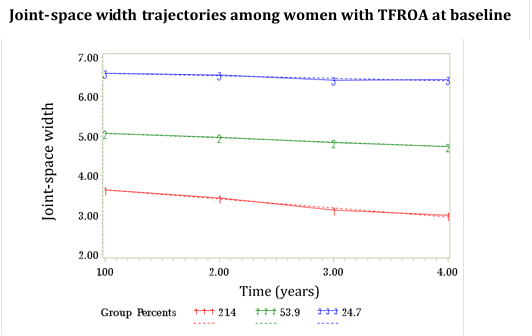Session Information
Date: Sunday, November 8, 2015
Title: Osteoarthritis - Clinical Aspects Poster I: Treatments and Metabolic Risk Factors
Session Type: ACR Poster Session A
Session Time: 9:00AM-11:00AM
Background/Purpose: Trials regarding bisphosphonate (Bisph) effects in knee osteoarthritis (OA) have been conflicting, and are unable to provide insights into long-term effects. While Bisph may have beneficial articular cartilage effects, there are theoretical concerns about their long-term effects on bone due to decreased bone turnover, which could have consequences for bone’s biomechanical properties. We therefore sought to evaluate the effects of incident Bisph use (to avoid prevalent user bias) on joint-space width (JSW) among knees with OA over a 4-year period.
Methods: OAI participants had bilateral fixed-flexion knee x-rays and clinical factors assessed at 0, 12, 24, 36, and 48 mo. We limited our sample to females with tibiofemoral radiographic OA (TFROA) at baseline, and defined incident Bisph users as those that did not report using a Bisph at baseline, but subsequently did so. Quantitative radiographic JSW was assessed with software that delineated the margins of the femoral condyle and tibial plateau and measured JSW at fixed locations with respect to an anatomical coordinate system. We focused on medial JSW at x=0.250 (ICC >0.99) among all knees, and stratified by baseline radiographic OA (ROA) status. To be included, JSW measurements had to occur in ≥2 visits, with appropriate film quality, beam angle, and tibial plateau-rim distance. We agnostically categorized knees into distinct groups of JSW loss using a group-based semiparametric mixture model to identify these trajectories (SAS macro proc traj). This method does not force data to fit a particular model, and improves precision by using several measurements. Follow-up time for the trajectory determination started at the visit at which incident Bisph use was identified, or at the 12-mo visit for non-users. The number of distinct trajectories was determined by optimal model fit statistics (BIC), and we required trajectory differences of ≥10%. We then examined the relation of incident Bisph use to JSW trajectory groups using logistic regression, adjusting for age, BMI, knee injury, education, prior fracture, and baseline KL grade.
Results: There were a total of 1303 female subjects who had TFROA at baseline and the necessary JSW readings, with 65 incident users. Three distinct trajectory groups were identified (Figure), with rates of JSW loss being 0.23 mm/yr for group 1 (21.4% of the sample), 0.11 mm/yr for group 2 (53.9%), and 0.06 mm/yr for group 3 (24.7%). Incident Bisph users were less likely to be in group 1 (worst group) than group 3 (best group) compared with non-users, though this was not statistically significant (adj. OR 0.60, 95% CI 0.26-1.04). Similar results were found for incident Bisph users in group 2 vs. group 3 (adj. OR 0.65, 95% CI 0.34-1.24).
Conclusion: Incident Bisph use may be associated with a lower rate of JSW loss, but we lack sufficient precision to definitively assess this relation.
To cite this abstract in AMA style:
Neogi T, Lu N, Niu J, Duryea J, Zhang Y. Relation of Incident Bisphosphonate Use to Trajectory of Joint-Space Width [abstract]. Arthritis Rheumatol. 2015; 67 (suppl 10). https://acrabstracts.org/abstract/relation-of-incident-bisphosphonate-use-to-trajectory-of-joint-space-width/. Accessed .« Back to 2015 ACR/ARHP Annual Meeting
ACR Meeting Abstracts - https://acrabstracts.org/abstract/relation-of-incident-bisphosphonate-use-to-trajectory-of-joint-space-width/

